Search & Destroy Operations in Vietnam: 1965-1975
Based on conversations with fellow gamers, I think that Victory Games 1980s title Vietnam: 1965-1975 has gotten miscategorized as an ultra-complex war game. Whenever I would suggest it to the group, I’d get the same eye-rolling reaction, “Uhhhhhhh-ohhhhhhhh…. not that game.”. While it’s true that the game has many, many moving parts, the heart and soul of the operational component, the Search & Destroy operation, is not terribly complex.
This “How-To” article will take you on a guided tour of a typical American Search & Destroy operation.
Starting Positions
For our demonstration let’s assume the 1st Marine Regiment, operating out of Quang Tri city in I Corps, has been tasked with eliminating a Viet Cong force of unknown strength that has been intimidating villagers in the area of the Phong Dien, a provincial town southeast of Quang Tri. Currently, two battalions of 1st Marines are conducting operations in the foothills west of the city, keeping an eye on a suspected NVA force in the mountains, which leaves only the 1st Battalion, the HQ element and a battery of 155mm artillery to support the Phong Dien operation.
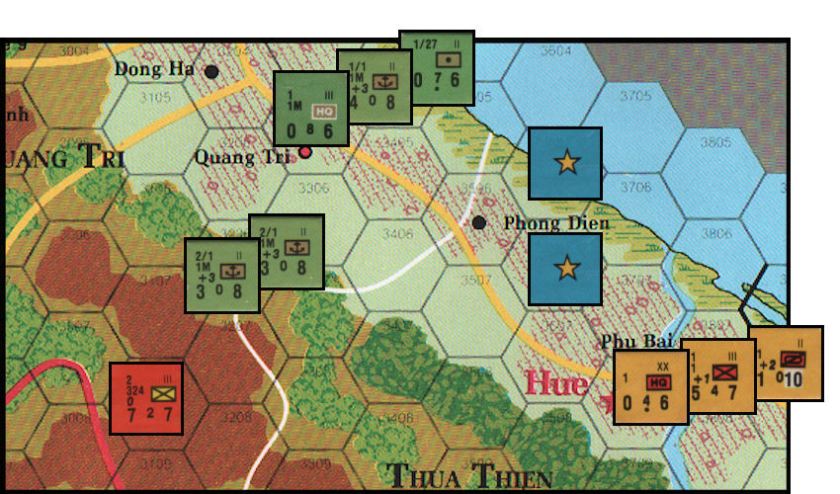
Elements of the ARVN 1st Division are headquartered in Hue city, about 30 miles south of Quang Tri, and can be counted on as a blocking force to prevent the VC from evading to the south. Two ARVN Ranger battalions are available to support any American or ARVN combat ops.
Very little solid intelligence exists regarding the actual strength of VC forces near Phong Dien. The NVA in the mountainous area near Laos are estimated to be present in at least regimental strength.
U.S. Search & Destroy Operation
The following sections below describe the steps shown on the Search & Destroy flow chart:
Designate Units
Any number of combat units may be assigned to the operation. Anything from a single battalion to multiple divisions can be designated as operating units. The US player decides to assign the Marine 1/1 (1st Battalion, 1st Marine Regiment) unit currently in the town of Quang Tri, and the ARVN 1st Division’s armored cavalry unit located in Hue city (the 1-strength unit).
Is Operation US Search & Destroy?
Since the operation is a US Search & Destroy (“US” in this case also includes ARVN and FWA operations; i.e. NOT an NLF operation), the US player may “roll for Rangers and place if desired“. The only good reason not to roll for Rangers is because the presence of ARVN units (even just ARVN Rangers) allows the Viet Cong an advantage during Alert (see below). Since an ARVN unit is already involved in the operation, there’s just no reason at all not to attempt to place Rangers.
Compare the Ranger die roll to the number of Rangers currently in play (i.e. the number of Rangers that have been purchased by the ARVN). If the die roll is less than, or equal to, the number of Rangers in play, that many Rangers may be used in the upcoming operation subject to placement restrictions. Since there are two ARVN Ranger battalions in play in our example, he must roll a two or less. The placement restrictions further limit the number of ARVN Rangers that can be placed to the number of hexes occupied by units designated as being involved in the operation. Assume that a 1 is rolled, so only 1 ARVN Ranger may be placed in either of the hexes containing the “operating” units. The hex containing the ARVN battalion is chosen for placement.
Select Target Hex
One hex must be designated as the “target” hex. 99% of the time, the target hex will contain one or more enemy units, although that is not required. There are weird situations where the US player may need to designate a target hex that’s off in space somewhere. Odd situations like this usually just represent another form of Strategic Movement, with the advantage that multiple stacks of units can be designated and moved simultaneously whereas a true Strategic Movement operation only allows a single stack at a time to be designated. In this example, the Cultivated hex southeast of Phong Dinh (containing a VC unit) is chosen as the “target” hex. Remember that it’s the hex that is chosen to be the target of the operation. Enemy units in the hex, if any, become “target units”.
Declare Support/Free-Fire
The US Player may assign Air or Naval support to the operation, and may declare any province to be a “Free-Fire” zone. US artillery and air strength only functions at 50% effectiveness (i.e. is cut in half) in a non-Free-fire zone. This step really only applies to the US/ARVN player, since the NLF has no air or naval power, and always treats the entire play area as a Free-fire zone. In this example, the US player declines to designate Thua Thien province a free-fire zone, mainly because of the associated victory point penalties (or, in the campaign game, the “Pacification” penalties).
A total of 6 Air Points are declared by the US Player for this operation. Shift the Air Points marker 6 spaces down the track to reflect the usage of these air points.
Movement/Reaction
The operating player (US, in our example) is now allowed to move all of the units that were assigned to the Search & Destroy Operation. Operating units may spend their full movement point allowance, possibly enhanced by Airmobile or Riverine points. If any Operating units end their movement adjacent to non-target units, those non-target units are eligible for a Reaction move. A reacting unit may spend its full movement point allowance to move anywhere it wants; away from the Operating unit and target hex, or even directly into the target hex, thereby instantly making itself a target unit. (Note that target units never get Reaction. They may perform “Alert”, however, as we’ll see shortly)
Operating Unit movements as follows (refer to the Movement Chart for terrain MP costs):
- ARVN Ranger – (“Foot” MP costs) Spends 1 MP to enter the Cultivated hex directly north of Hue city.
- ARVN 1 Divison Cav Unit (“Mech” MP costs)- Spend 1/2 MP for the first road hex, +1 MP to leave the VC unit’s Zone of Control, then another 1/2 MP to move an additional hex down the road, for a total of 2 MP spent.
- US 1/1 Marine Unit (“Foot” MP costs) – Spends 1 MP for each of the two road hexes southeast to the town of Phong Dien for a total of 2 MP spent.
Since the US Marine unit has ended its movement adjacent to a VC unit that is NOT a target unit (i.e. the unit in hex 3605, north of Phong Dinh), that VC unit is eligible for a Reaction move. The eligible VC unit decides to react southeast into a Marsh hex. It pays +1 MP to leave the US Marine unit’s Zone of Control and 3 MP to enter the Marsh hex for a total of 4 MP spent (even though we haven’t yet seen the front side of this VC unit, trust me, it has a MP allowance of 6).
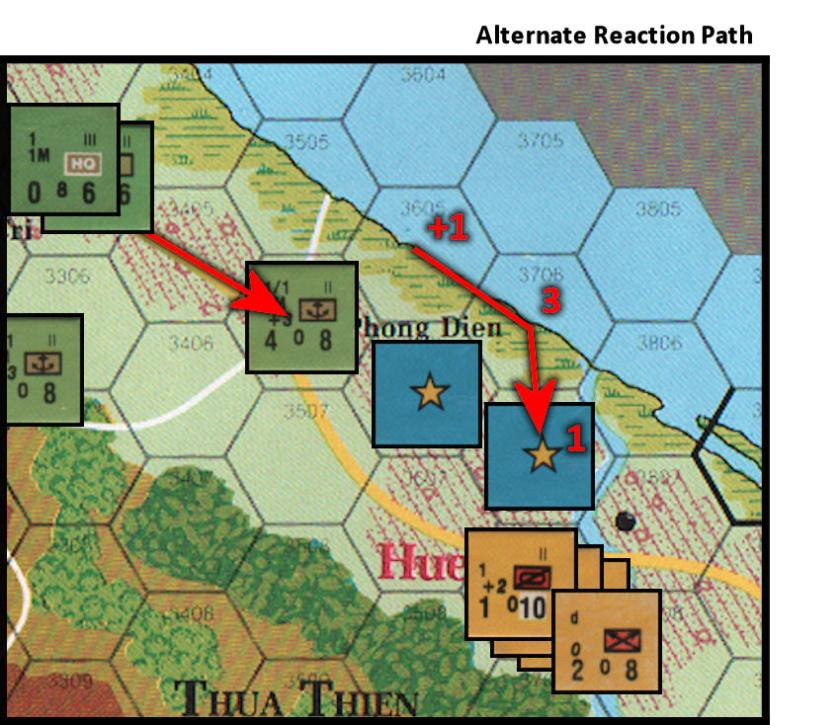 Such a reaction move would have totally screwed up the blocking position the US Player had planned for the ARVN Ranger. Care must be taken to not “shoot ones self in the foot” while maneuvering during Search & Destroy operations!
Such a reaction move would have totally screwed up the blocking position the US Player had planned for the ARVN Ranger. Care must be taken to not “shoot ones self in the foot” while maneuvering during Search & Destroy operations!Offensive Interdiction
The operating player may opt to “Interdict” a hex, using air points and/or artillery to increase the movement point cost of a hex by +1 or +2 MP. It costs 3 effective (i.e. taking non-free-fire penalty into account) support points in order to interdict the hex by +1, and 7 effective support points to interdict by +2. The US player has 6 Air Points assigned to the operation, cut in half because he declined to make the province a free-fire zone, leaving only 3 “effective” support points for a +1 Interdiction Marker.
He decides to place the Interdiction Marker directly on top of the target VC unit, thereby making it more difficult for the unit to escape (as we’ll see in just a moment).
Are There VC Defenders? – If YES, Alert Roll, Dispersal, Alert Move
The target units are VC so they may attempt to escape, although they are not required to. The following procedure is completed:
- Alert Roll – The “Foot” movement point cost of the terrain occupied by the “alerting” unit is added to a single D6 die roll. This total is the number of movement points the VC unit may spend immediately (either to escape or maybe to better position itself). Since there are ARVN units involved in the operation, an additional +1 is added to the total (to indicate, I suppose, that the ARVN were heavily infiltrated by VC sympathizers). Let’s assume a die roll of 4. The “Foot” movement cost of cultivated terrain is 1. So 1 plus the die roll of 4 plus the additional 1 for ARVN involvement returns a total of 6 MPs the VC unit can spend. Keep in mind that the Alert roll may end up being higher or lower than the alerting unit’s inherent movement allowance; this is allowed.
- Dispersal – At this point, if the VC player wanted to, he could simply “disperse” the unit. Dispersal removes the unit from the map and increases the VC Replacement Pool by an amount equal to the combat value of the dispersed VC unit (more about uses of Replacement Points later). In most of the scenarios, a “dispersed” VC unit is just as good as a dead one for victory point purposes. But dispersal does replenish the Replacement pool, which means the US will have to fight them again another day. Probably the best thing about Dispersal is that it causes the operation to end immediately. This can come in handy if some powerful US units are moving against you, since each unit is only eligible to perform operations once during a Game Turn. It’s also the main reason why an experienced US player will send out a smaller force to attempt to pin the VC down before committing larger formations.
In this example, our VC player feels that he has sufficient Alert movement points to position the unit where he wants it to be and therefore declines to Disperse. - Alert Move – The VC unit spends its 6 Alert MP (shown in the following diagram) as follows:
1 MP to leave enemy zone of control.
1 MP to leave the interdicted hex.
1 MP to enter the Cultivated hex to the southwest.
1 MP to again leave enemy zone of control (Note: Most ARVN battalions, except for Rangers, have no ZOC. But in this case, the VC unit is also adjacent to the ARVN Ranger as well as the 1st Division Regiment in Hue city, both of which exert ZOCs)
2 MP to enter the adjacent Jungle hex.
For a total of 6 MP spent.
Any target units in adjacent hexes or hexes occupied by operating units? If YES, Offensive/Defensive Interdiction
Now, both attacker and defender are given the opportunity to use support points for Interdiction. The attacker may want to rain down more interdiction on the VC unit to slow it down further. A defender may want to interdict in order to cover its retreat or to impede attacker pursuit.
Since the US player has no more unused support points (Air or Artillery) involved in the operation, and the VC player does not have any artillery units near by, both players will decline additional interdiction.
Any Operating Units in Target Hex?
If there are operating units in the same hex with target units, then combat must occur. If there are operating units adjacent to target units, then combat may occur, at the operating player’s discretion. If no operating units are in or adjacent to any target units (i.e. they got clean away), then combat will not occur and the operation ends immediately.
In our example, the ARVN Cav Sqdn is still adjacent to the target VC unit so combat may occur. However, note the following:
- Neither the US Marine unit nor the ARVN Ranger may take part in this combat round. A attacking unit must be in contact with the target unit (i.e. same hex or adjacent hex) in order to lend ground strength to the battle.
- The Air Points assigned to the operation cannot be added to the total attacker combat strength because it was used this round for interdiction instead. Air Points can be used once each combat round so its still part of the operation and may be used next round (if not used again for interdiction).
- It may seem like a really weak attack, since only the 1-strength ARVN unit can actually take part in the attack against God-knows-how-many VC strength points in that as yet unrevealed VC unit. It not only seems like a really weak attack, it is a really weak attack! But don’t fret, US Player, if you survive this first combat round, you’ll be able to activate “Offensive Reserves” to assist with the next combat round.
Our savvy US/ARVN player knows that when you’ve got a VC unit by the tail, you don’t let go! He decides to proceed with the attack.
Determine Modifiers to Combat Die
Now that combat is a certainty, we finally get to see what lurks on the flip side of the hidden VC unit. It turns out to be a 1-strength VC battalion, with 1 organic artillery point. A relief to the US/ARVN player who was sweating out the possibility that he stumbled upon a really strong battalion or even a VC regiment, although the VC unit is still twice as powerful as the ARVN unit. The following die roll modifiers are now applied:
- Terrain – Jungle terrain gives a slight advantage to the defender in the form of a -1 combat die roll modifier.
- Combat Ratio – The ARVN unit has a total combat strength of 1. The VC has a total combat strength of 2 (1 ground + 1 artillery), so combat ratio (attacker to defender) is 1 to 2, providing a -2 combat die roll modifier. Note that, if the Air Points had not been used for Interdiction, they would have been added to the ARVN unit ground strength for a total of 4 total strength (1 ARVN ground + 3 “effective” Air Points), changing the combat ratio.
Combat Die Roll
The final die roll modifier is -3 (-2 for combat ratio and -1 for terrain). The US player rolls a 6, which is modified down to 3, and the combat round is resolved as follows:
- On the Combat Results Table, under the “Modified Die” column, find the “3” row.
- Apply Defender Casualties – Add the support strength of the attacker to the ground strength of the defender. In our example, we’ll be adding the US support strength of zero to the VC ground strength of 1, for a total of 1. Therefore we’ll be locating the VC combat result in the “1 to 3.5” column. Cross-reference the “3” row with the “1 to 3.5” column and look at the number on the right side of the slash. This is the number of losses (hits) the defender must take. The chart shows zero, so the VC are not required to take any losses. Note the combat dynamic here. Assigning lots of Air and Artillery support to the operation will do more to inflict heavier casualties on the enemy than adding ground strength will.
- Apply Attacker Casualties – Add the support strength of the defender to the ground strength of the attacker. The ground strength of the ARVN unit is 1 and the support (artillery, in this case) strength of the VC unit is 1, for a total of 2. This also points to the “1 to 3.5” column of the Combat Results Table. This time we look at the number on the left side of the slash for attacker casualties, and find that it is also zero.
- An important bit of information on this row of the Combat Results Table is the airplane graphic to the left of the number 3. This indicates that the U.S. permanently loses an Air Point at the end of the operation. If there were no Air Points assigned to the operation, it would have no effect. But since we did assign 6 Air Points, one of them will be permanently lost at the end of the operation. Note that the point is still available for the duration of the current operation.
- Pursuit – The last bit of information we need to capture on this table row is the “PURSUIT” number, located in the last column. This is a modifier that will be used in the next combat round (if one is fought). Pursuit represents the building of momentum in an operation or, as in our example, the loss of momentum. Make a mental note of this “0” Pursuit result and proceed.
Retreat/Defensive Reserves Activation and Movement
Neither side took a hit in the first round of combat and the VC might be tempted to just sit tight and slug it out for another round, but our wiley VC commander knows that additional firepower, in the form of Offensive Reserves, will most likely be coming his way and opts to retreat to a more advantageous defensive position.
A retreating unit may spend its full movement point allowance. In this case, the retreating VC spends 6 MP, 3 each for the two Forest hexes. Note that since most ARVN battalions do not exert zones of control, our VC unit does not have to pay the +1 MP penalty to leave a ZOC. If it had been adjacent to the ARVN Ranger unit or the US Marine unit, it would have had to pay the ZOC penalty. The VC have fallen back into the Forest and await further developments. Although he could have retreated into the Mountain hexes to the west, since they cost the same number of movement points to enter as Forest hexes do, our VC commander chose not to as that would place him way out in the boonies and he would rather stay closer to the coastal areas where he can menace the valuable towns and cultivated hexes along the coast.
The NLF is not allowed to activate Defensive Reserves; this is an option for the US Player only. When the US Player is defending, he may designate any number of units as Defensive Reserves and may spend the full movement point allowance of any units so designated. Normally, Defensive Reserves would attempt to either move into the same hex as the current target units, thereby becoming target units themselves, or they may want to just set up as a blocking force to interfere with the attacker’s pursuit. In any case, the VC are not eligible for Defensive Reserves and so nothing is done.
Pursuit/Offensive Reserve Activation and Movement
Now things really start getting interesting. Not wanting to let the VC unit escape unscathed, the US Player would really like to pursue it and fight another combat round, hopefully with better odds. Let’s review US options:
Units pursue using the “Pursuit Modifier”, printed on the counter (on the left side, just above the combat strength number). The only possible modifier to this is the “Pursuit Result” retained from the prior combat round. If you recall, it was “0”. Regular movement allowances are suspended, and only the pursuit value is used for pursuit movement and combat. Therefore, the ARVN Ranger has net 0 movement points available for pursuit (0 pursuit modifier, 0 pursuit result from last combat)… so he’s not going anywhere. The ARVN Cav Sqdn has an intrinsic +2 pursuit modifier (unaffected by the 0 pursuit results from the last combat). Finally, the US Marine unit has a net pursuit movement allowance of +3 (+3 intrinsic + 0 pursuit result from prior combat).
The ARVN Ranger unit is just stuck, so forget them. The ARVN Cav Sqdn has +2 pursuit, but recall that this is a mechanized unit; movement off the road (other than Grassland hexes) is expensive for mech units, so they won’t be able to get into the action. The US Marine unit, with +3 pusuit movement, has just enough pursuit to get adjacent to the retreating VC unit (1 MP for the Cultivated hex and 2 MP for the Jungle hext adjacent to the VC). Notice that the U.S. unit used all of its pursuit allowance to get adjacent to the target unit. If the US unit had only used part of its pursuit allowance to get in position, it would retain the balance of its pursuit to be used as a combat die roll modifier. Example: If the US unit only spent 1 MP moving adjacent to the VC unit, it would retain the +2 balance of its total pursuit allowance as a combat die roll modifier. Again, the concept of momentum in combat operations is brought to life via clever game mechanics.
So now we have a 4 strength Marine unit, with potentially 3 Air Points (6 points cut in half for no free-fire) up against 2 defending points (1 ground/1 artillery). The odds in the upcoming round could be as high as 3 to 1. But, in addition to putting some hurt on the VC unit this round, the US Player also wants to do all possible to prevent its escape via retreat after the round is over. All of our original operating units have been accounted for, so additional help must come in the form of Offensive Reserves.
The US Player may designate any number of units (not currently involved in the operation) as Offensive Reserves. In this case, the 2nd Battalion of the 1st Marine Regt (i.e. “2/1” US unit) and the 105mm Artillery unit in Quang Tri will be designated as Offensive Reserves. Offensive Reserves may spend their full (normal) movement point allowance. Air mobile and Riverine movement is also allowed. They become “Operating Units” from that moment on.
The US Artillery unit spends 1 MP to move into the Grassland hex 3306 (Grassland only costs 1 MP for mech units as well as foot units). This puts the artillery unit within range of the target VC unit. Next the newly activated US Marine Battalion makes a bold move. He moves directly into the hex with the VC unit, spending 3 MP for Forest hex 3307, 1 MP to leave the VC unit’s zone of control, and finally another 3 MP to move into the Forest hex with the VC unit. Note that he was careful to stay out of the zone of control of the NVA unit, which would have slowed him down. And, most importantly, he was careful not to end his movement adjacent to the powerful NVA unit which would have allowed the NVA to make a Reaction move (since it is not a target unit), and who knows what kind of trouble that could have led to!
Remove Interdiction Markers
All Interdiction markers are removed as we prepare to (possibly) begin another round of combat.
Any Operating Units In or Adjacent to Target Hex?
If there are any Operating units in the same hex as a target unit, then there must be another round of combat. If Operating units are merely adjacent to any target units, there may be another round of combat at the attacking player’s discretion.
In our example, the US Marine unit, newly designated as Offensive Reserve, is in the hex with the target VC unit, so there must be combat. We return to the “Offensive Interdiction/Defensive Interdiction” step and repeat that and all subsequent steps for this next round of combat.
Second Combat Round
Offensive Interdiction/Defensive Interdiction
This time the US declines any Interdiction, conserving all Air and Artillery points for combat.
Determine Modifiers to Combat Die
The following die roll modifiers are applied:
- Terrain – Forest terrain provides a -2 combat die roll modifier.
- Combat Ratio – The US has a total combat strength of 13.5; i.e 7 ground, 3 Air Points (6 cut in half), and 3.5 Artillery points (7 cut in half). The VC still has a total combat strength of 2 (1 ground + 1 artillery), so combat ratio is now is 6 to 1, providing the maximum allowable combat modifier of +5
Combat Die Roll
The final die roll modifier is +3. The US player rolls a 3, which is modified up to 6, and the combat round is resolved as follows:
- On the Combat Results Table, under the “Modified Die” column, find the “6” row.
- Apply Defender Casualties – Add the support strength of the attacker to the ground strength of the defender. Now, the impact of the massive US support advantage will be felt. When we add the VC ground strength of 1 to the 6.5 total US support points, we get a total of 7.5, so we’ll be apportioning VC losses based on the “4 to 7.5” column. Cross-reference the “6” row with the 4 to 7.5″ column and find the defender losses on the right side of the slash. The VC unit must take 2 losses. Since it is only a 1 ground strength unit, it may not absorb 2 losses using Replacement Points and therefore must be eliminated.
- Apply Attacker Casualties – Add the support strength of the defender to the ground strength of the attacker. The US has a total of 7 ground strength points committed to the battle. Add to this the single VC artillery point for a total of 8. The US will therefore be taking losses in the “8 to 13.5” column. Looking at the “6” row of this column, left side of the slash for attacker casualties, we find that the US takes 1 loss. The loss is absorbed by spending a single Replacement Point, and none of the ground units need be removed. If the US had no Replacement Points to spend, or if he somehow took more than 7 losses (the maximum that 7 ground strength points can absorb), he would then have had to remove a unit.
- Finally, note the “PURSUIT” modifier on the combat chart for the “6” row is +2.
Wrapping up the Combat
The VC unit is eliminated, but the US player may still “pursue”, as in the last round. Pursuit, in cases where the enemy has been eliminated, is usually used to reposition units for best advantage. Remember that these operating units will not be eligible for any further movement or offensive operations (except for Reaction Movement or Retreat, during NLF operations), so you’ll want to leave them in as tactically sound a position as possible.
Adding the pursuit bonus from the combat chart (+2) to the intrinsic pursuit allowance of each unit, determines how many movement points each unit may spend. The US Marine battalions both have +3 intrinsic pursuit for a total of +5 pursuit each. The 2/1 battalion spends 3 MP to move adjacent to the NVA unit, hoping to keep it bottled up in the mountains and away from the vital coastal areas. Note that this movement may trigger “reaction”, at the NVA Player’s discretion. Our NVA Player decides to stay put.
Finally, the 1/1 Marine battalion moves back into the town of Phong Dinh, reassuring the villagers that the VC reign of terror is over, and helping to box in the remaining VC unit to the east of the town.
Even though the ARVN Ranger unit is eligible for pursuit, using the +2 from the combat chart, it really doesn’t make sense to move it since Rangers disappear at the end of any operation they’re assigned to. However the ARVN Cav unit is eligible to spend 4 MP (2 intrinsic, 2 from the combat pursuit bonus), but chooses to stay put.
Thus ends the operation. All formerly operating US and ARVN units are capped with “Ops Complete” markers, the ARVN Ranger is simply removed from the map, and the operation is considered terminated.
Summary
I hope this article has given a good sense of the flow of a normal Search & Destroy operation. You can see that, due to the Alert/Disperse mechanisms, the VC player retains a great deal of control over when combat will actually take place. A massive US operation can grind to a screeching halt, if the intended target rolls high enough on Alert to get him safely out of range of his attackers. Failing that, the VC unit can simply disperse and end the operation that way. If he hopes to win the game, however, he will at some point have to stand and fight.
Conversely, a small skirmish can escalate into a major battle using the very fluid retreat/pursuit/react rules. VC units can retreat/react into clusters or stacks, forcing the US to either abandon the fight, or reinforce with Offensive Reserves. As you can see, not many war games provide the interactivity that you’ll find in Vietnam: 1965-1975. You are always completely engaged, even while your opponent is moving, as you watch closely for reaction opportunities.
Search & Destroy operations are always unpredictable and exciting… but not terribly complicated. Dust off this great classic and give a shot! You know you want to…
Feedback
Mark,Thanks for writing that article on Search and Destroy operations. I enjoyed playing Vietnam a while ago and am now encouraged to dust it off.
By the way, the procedure that you refer to as “not terribly complex” took about 5000 words of explanation, which is longer than the (amendment-free version of) the US Constitution!
— John S., Charlottesville, VA


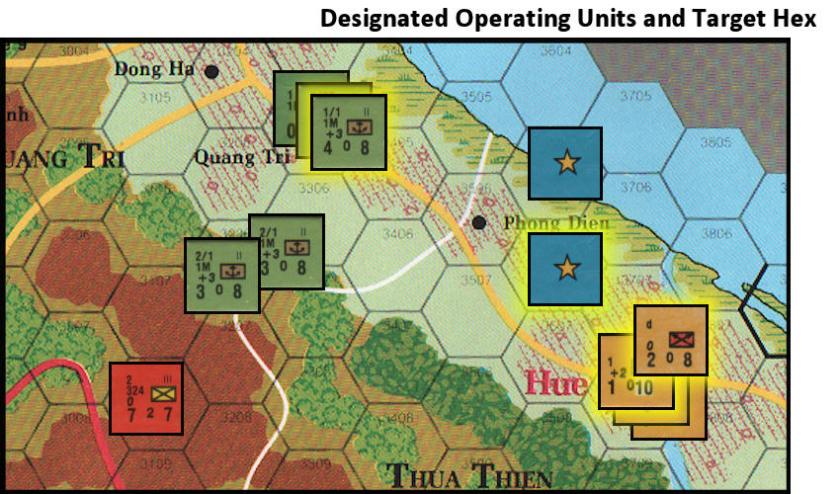
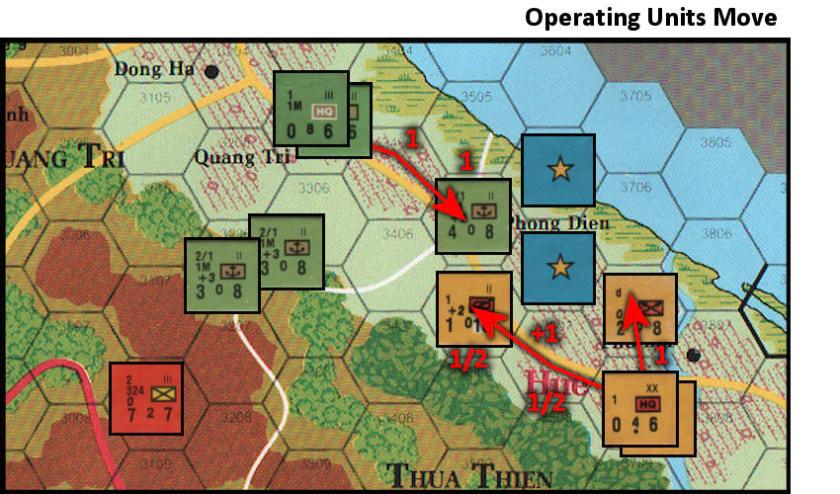
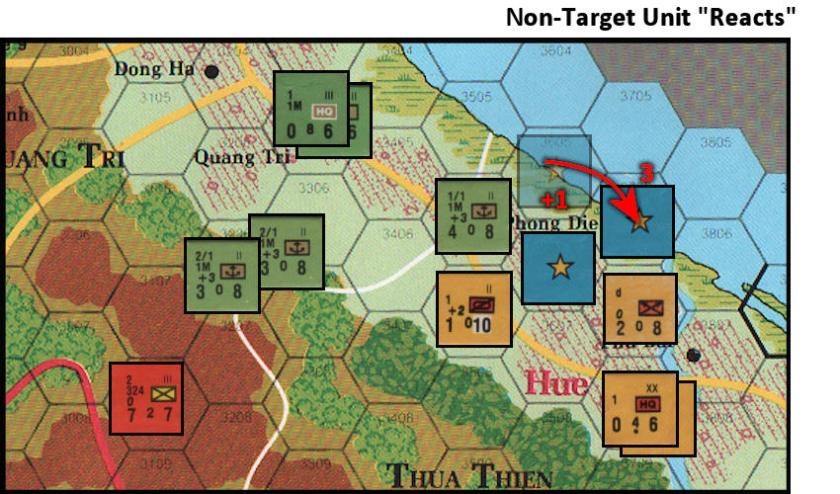
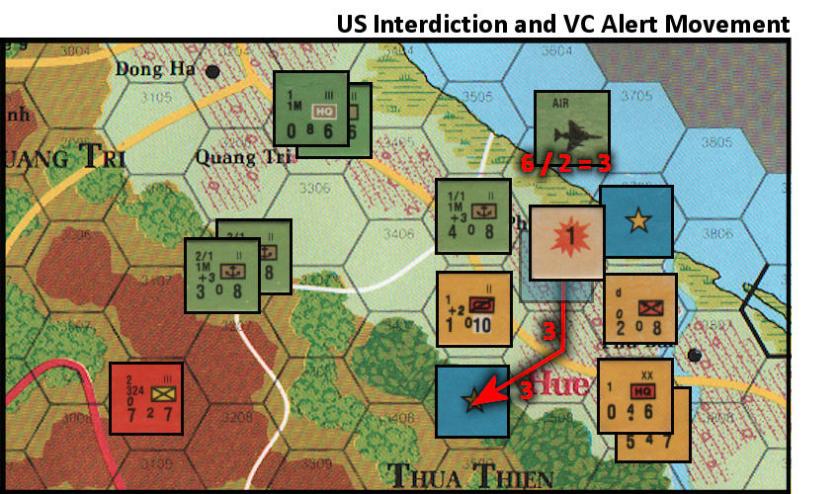
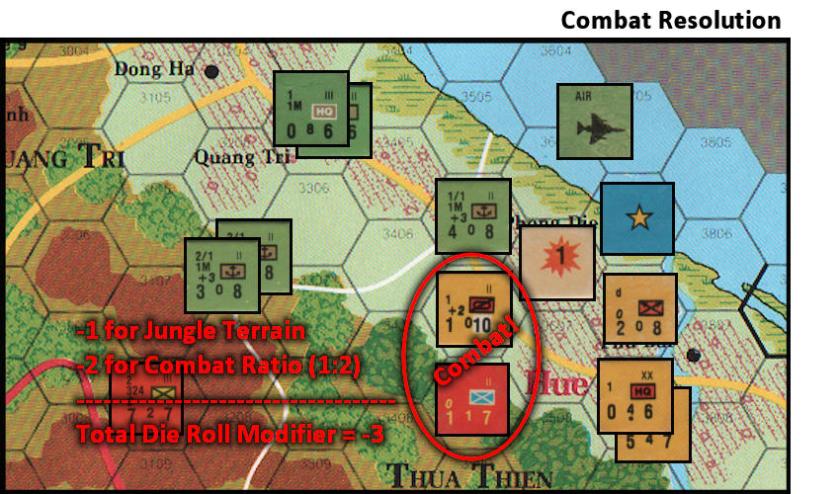
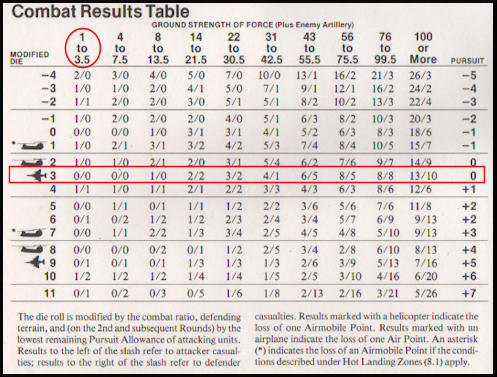
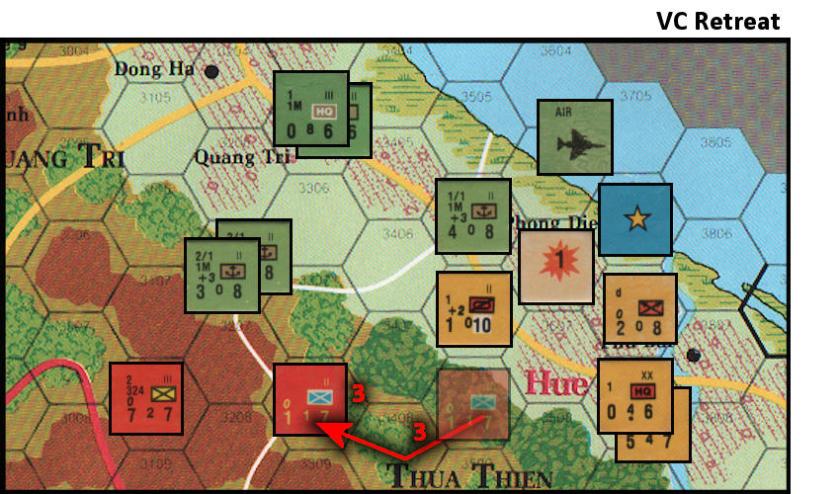

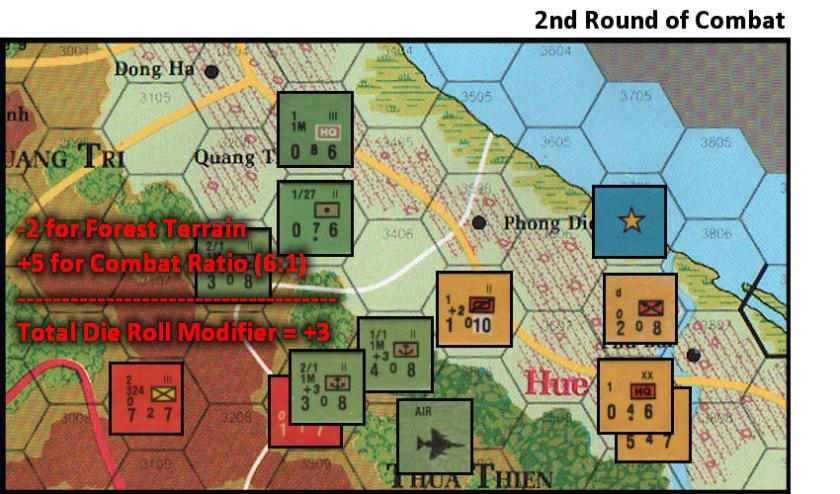

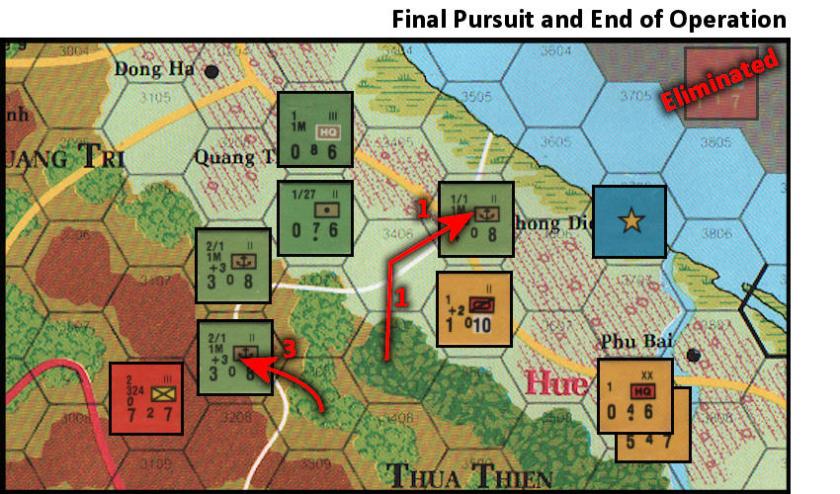
Hi Mark,
I have a question regarding Reaction movement and units that are operations complete. Can an operations complete unit still conduct reaction movement? Possibly even entering the target hex and participating in the defence of the target hex?
Also, can artillery on an operations complete unit still be used if all the other support requirements are met?
Btw your anatomy of a S&D operation was excellent. Many thanks!
Richard,
Yes, Ops Complete units may still react and enter the target hex to participate in the defense of the target hex, subject to the same restrictions as any other unit:
1. The unit cannot be a participant in the operation either as operating unit or target unit.
2. If the unit is reacting to the movement of a retreating unit or the movement of Defensive Reserves, it may still react, but it may not end its reaction movement in a target hex.
Glad you enjoyed the article!
+Mark
Richard,
Sorry for missing your second question. I’m not 100% sure that this is what you’re asking, but the rules do allow Ops Complete artillery units to fire *defensively* (see the “DEFENSE” section under rule 7.1, “Firing defensively is not considered an operation and does not render an artillery unit ineligible for further operations.”)
Thanks Mark!
My project this summer is to solitaire a campaign game of this classic. I’ve already printed off the modified record sheets you’ve provided and am looking forward to sinking my teeth into it. I’m a sucker for pain – I even solitaired Harpoon4!
Hi Mark,
During the offensive reserve movement of the 2nd Battalion of the 1st Marine Regiment you mention that it avoided the ZOC of the NVA unit so not to slow it down. It still would of cost only 7 MP’s if he had gone that way or are ZOC’s cumulative?
Great article! Is this available as a PDF??